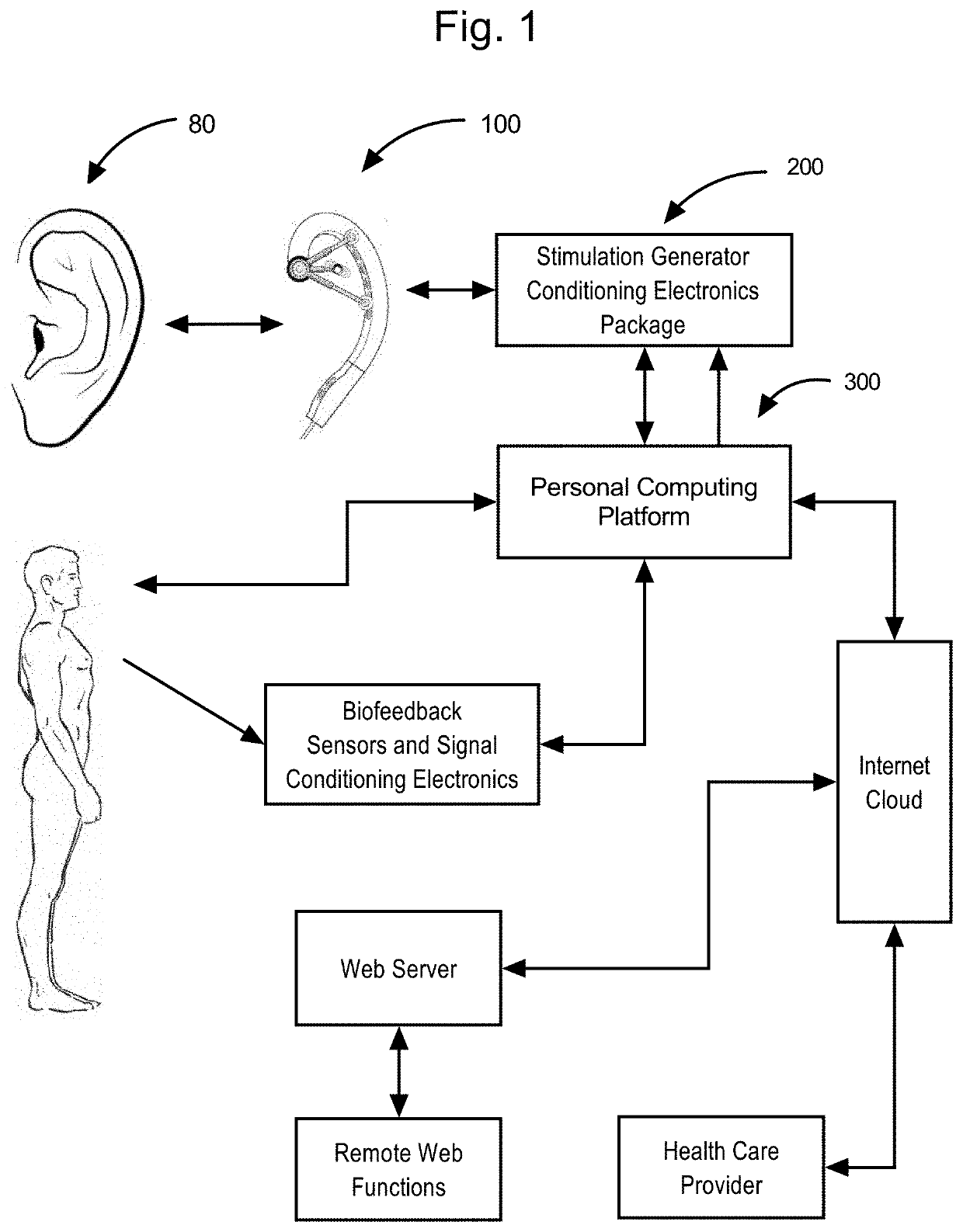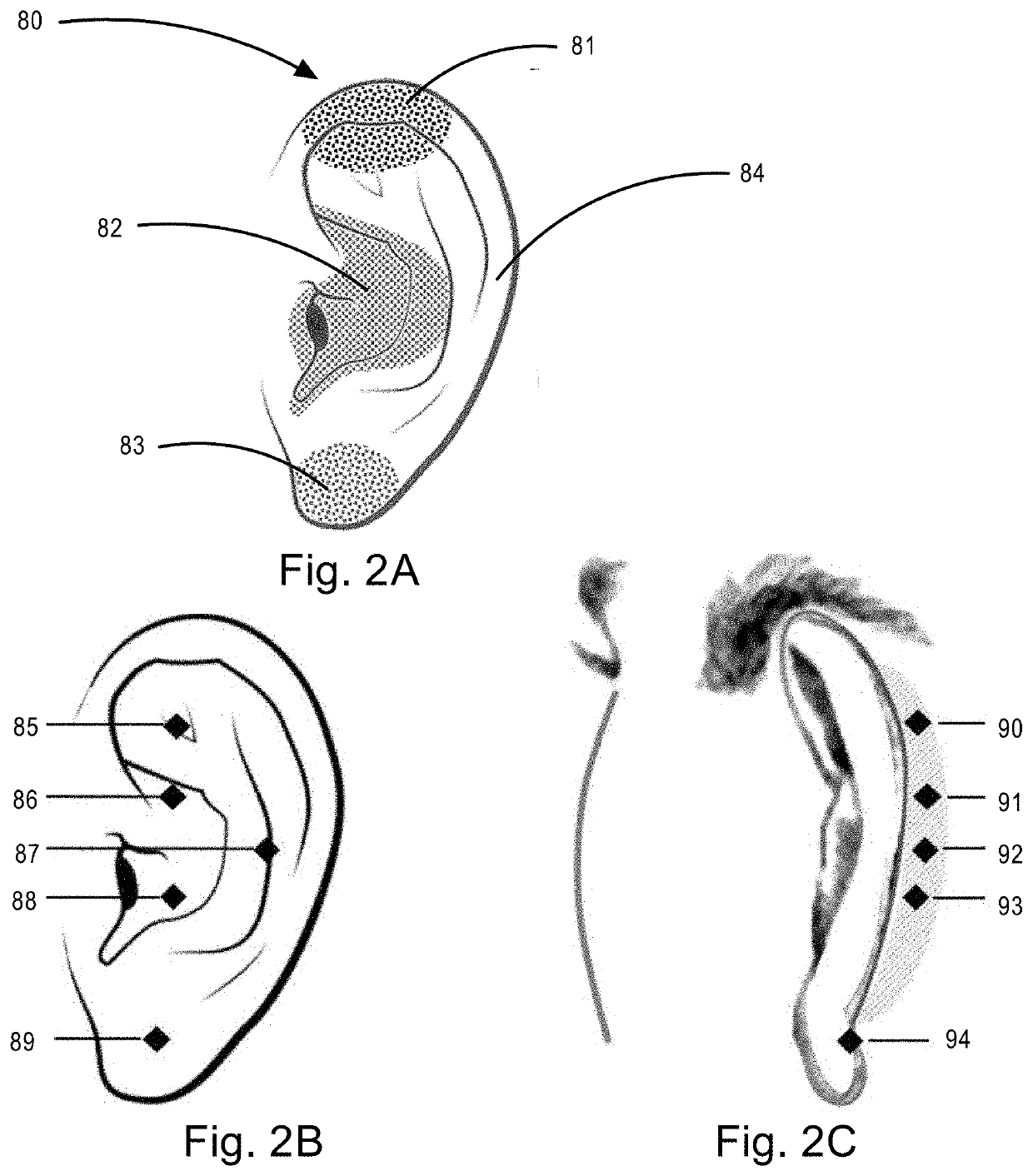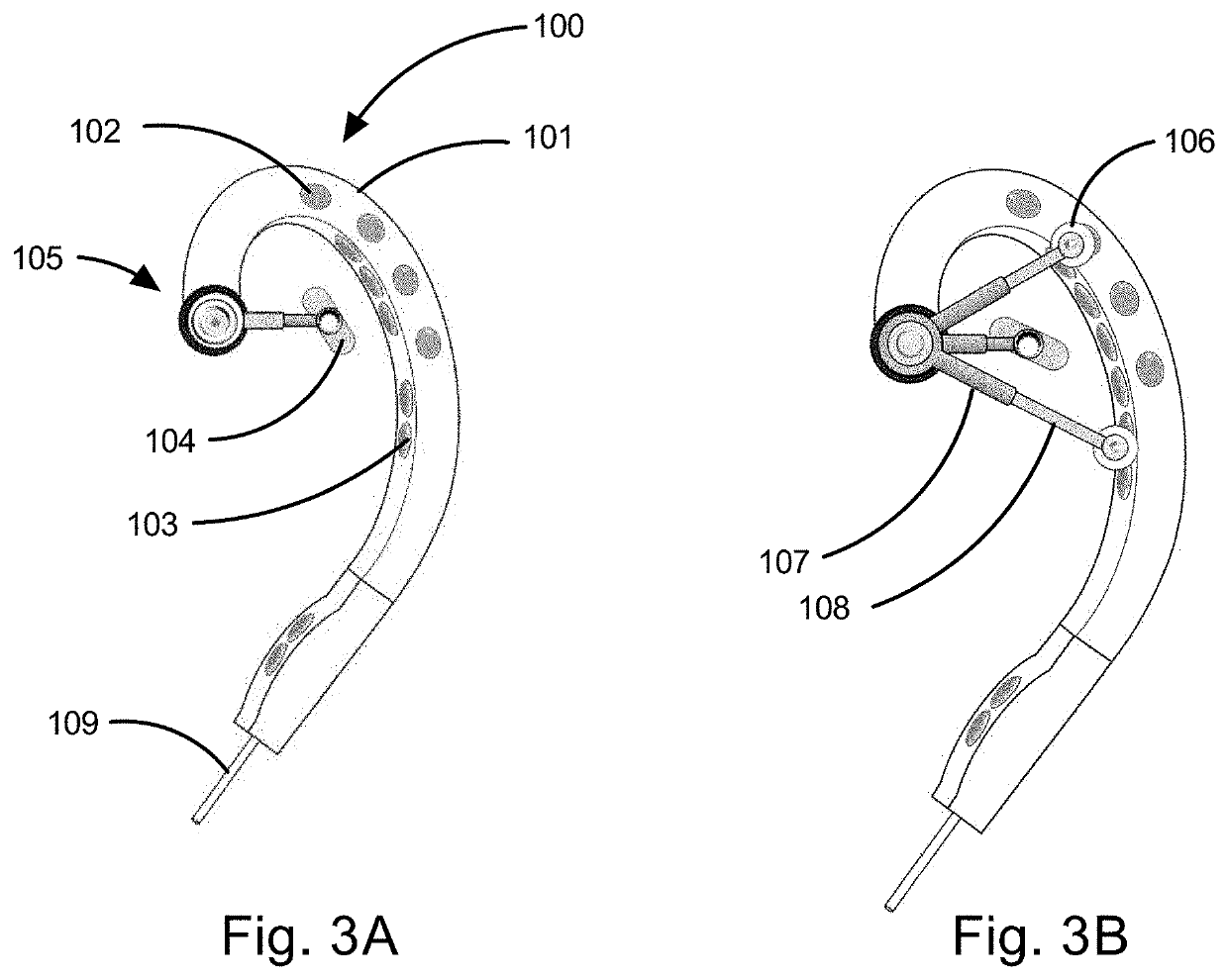Despite this anatomical access to the
vagus nerve, there are a number of challenges in designing the interface
coupling the stimulation device to the target area of human tissue using a coupler containing electrodes which transmit the stimulation signal transcutaneously across the
skin to the targeted nerve field.
As there is little subcutaneous padding in the
skin proximal to the superior and inferior contact points on the ear, the
spring force required for position retention and the
electrode contact maintenance may be poorly tolerated over prolonged periods of treatment.
Additionally, this
coupling scheme is limited to a single position which may be sub-optimal for many users, as the auricular nerve matrix and
tissue architecture of the ear can vary significantly from one individual to another.
Hence, the Nemos® lacks the flexibility to work effectively when other
electrode positions are required, as with those who not possess a matching combination of nerve matrix and
ear structure.
This
electrode location limitation does not accommodate variances in nerve field receptivity associated with normal anatomical variations in the ears of different individual users.
This means that the gravity drag of the cable weight and any additional gravity or sheering forces that may be suddenly applied to the cable, for example by
snagging the cable on a table corner or any one of thousands of other snag-risks, or by dropping the handheld controller, are immediately transferred to the anchor sitting in the conchal bowl, and thereby to the concha and the lower ear itself, potentially resulting in pain and injury to these sensitive tissues and psychological distress.
Relying on spring forces created by wedging the superior end of the
scaffold-like ear-piece against the superior
ridge of the concha cymba reduces the earpiece's resistance to motion-generated displacement, vibration and sheering forces produced by ordinary
activities of daily living.
Each of these transcutaneous electrode-to-
skin coupling schemes present potential and actual complications and challenges for a user.
The user of
adhesive collars is highly problematic on an uneven surface such as the
human ear and the use of
adhesive to secure an electrode against ear tissue and whilst withstanding gravity, motion and sheering forces may, upon removal, cause pain to the sensitive tissue of the ear of a user and require vigorous, skin irritating clean-up of the
adhesive.
The clamping force exerted against sensitive ear tissue for prolonged periods is a known source of discomfort to the user that can create a negative association in the mind of a user with stimulation therapy that may discourage compliance with a prescribed
treatment regimen, especially when the clamping is accompanied by perceivable, slightly uncomfortable electrical stimulation.
The
ear canal itself contains sensitive tissues and other structures that may be negatively affected by the
insertion and wearing of inserted electrodes which plug the ear canal.
The Nervana® ear-canal plug incorporates two conductive electrodes on what is essentially an audio-emitting ear-canal plug or “
bud.” A drawback with this ear-canal electrode anchoring scheme is illustrated by the fact that, according to its crowd-funding
web site, Nervana LLC has received various complaints from users about “burning” sensations in the ear canal.
This results in the uncomfortable presence of conductive liquid in the ear canal, which is known to loosen and mobilize ear
wax which may become attached to the inserted ear electrode.
This result is especially likely when a selected electrode site like the ear canal has low nerve receptivity, thus requiring higher current intensities.
The combination of small surface contact electrodes with low receptivity in targeted nerve sites virtually guarantees that higher current intensities will be required, thereby contravening Yerkes-Dodson law and raising the likelihood of electrode burns.
In addition to the fact that many users will fail to perform this manual coupling function reliably and as instructed, users quickly weary of functioning as couplers themselves, and the tedious, unpleasant task of coupling an electrode to the skin becomes an aversive experience in its own right, resulting in poor
treatment compliance which reduces treatment effectiveness.
Transcutaneous
nerve stimulation devices could produce less than optimal results for a number of reasons.
The barrier of skin and tissues between the stimulation emitter (e.g., electrode) and a nerve inside the body generates strong electrical resistance which weakens the power of the
electric signal delivered to the target nerve.
Most currently marketed transcutaneous auricular
neurostimulation devices do not, over time, adequately maintain a constant degree of user coupler
apposition to the skin, resulting in fluctuating, inconsistent and higher impedance which may reduce the degree of signal transmission through the skin, thereby reducing the strength of the signal reaching the target nerve.
Poor, inconsistent or unreliable position maintenance of the user coupler on the skin may disrupt the conductive pathway to the target nerve, causing ineffective treatment.
An obvious problem that arises with this side-by-side electrode arrangement is that the electrons emitted by the electrodes tend to follow the path of least resistance and flow between the two poles, especially since the electrical resistance of the skin is relatively high.
Higher energy levels can cause pain, burn the skin, and waste the limited
electricity of battery-powered
simulation devices.
High stimulation current levels may over-arouse both target nerves and the
nervous system itself thereby defeating the purpose of stimulation therapy.
For example, when a previously used location has been damaged or sensitized by excessive use,
high current intensity, or compressive forces applied by the coupling means.
Each of the aforementioned prior art schemes for locating, coupling and retaining a user-attached electrode may impose limitations on the user and clinicians which reduce the effectiveness of
transcutaneous stimulation of the
vagus nerve.
Translating such a treatment regime into non-invasive
transcutaneous stimulation employing surface electrodes poses a variety of challenges including the fact that, for some users, repeated and / or long term electrostimulation may burn skin tissues receiving
electrical current from is transcutaneous electrodes.
Weaknesses in design, functionality, flexibility, adaptability and
usability of the ear-electrode
system can limit the effectiveness of
neurostimulation, create safety hazards such as applying the ear-electrode to the wrong ear, and create pain, skin burns, discomfort and other barriers to
treatment compliance.
The absence of user-response feedback, both subjective and biological, during and over the course of neurotherapy may
pose a sufficiently and potentially
significant risk that it should be considered a risk of unmonitored
neurostimulation.
 Login to View More
Login to View More  Login to View More
Login to View More 


